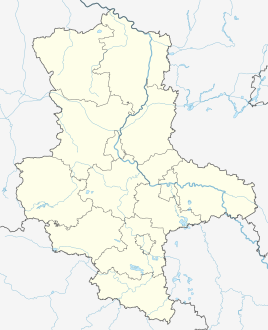Reinsdorf (Lutherstadt Wittenberg)
|
Reinsdorf
Coordinates: 51 ° 54 ′ 5 " N , 12 ° 36 ′ 43" E
|
||
|---|---|---|
| Height : | 88 m | |
| Area : | 14.95 km² | |
| Residents : | 1816 (March 31, 2016) | |
| Population density : | 121 inhabitants / km² | |
| Incorporation : | October 15, 1993 | |
| Postal code : | 06889 | |
| Area code : | 03491 | |
|
Location of Reinsdorf in Saxony-Anhalt |
||
Reinsdorf is a village in Lutherstadt Wittenberg in the state of Saxony-Anhalt . The districts of Braunsdorf, Dobien and Reinsdorf belong to it.
geography
Reinsdorf is in the south of the Fläming Nature Park . The Rischebach runs through the village, which then flows through the old town of Wittenberg and then flows into the Elbe .
history
Reinsdorf was an independent municipality in the Wittenberg district until 1993 . The districts Dobien and Braunsdorf belonged to it. Dobien was incorporated in 1937, Braunsdorf in 1950. Since the incorporation into Lutherstadt Wittenberg in 1993, the three districts have had a common district administration with a local council and a common local mayor .
Reinsdorf
The place was first mentioned in 1398 as Reymersdorf . The Saxon court marshal Löser awarded Reinsdorf in 1430 as a fiefdom . In the Thirty Years War the place was completely destroyed.
There were several mills in Reinsdorf:
- Hohe Mühle, 1330 the chapel of the Holy Cross in Wittenberg 1330 subject to interest, 1569 university mill , from 1813 fulling mill the drapery
- Neumühle, before 1573 powder mill, later grinding mill, closed in 1972
- Teichmühle, built in 1835/36, in operation until 1950
In Reinsdorf, a lignite mine was opened in 1870, from which the Mummelsee emerged after its closure.
WASAG (Westfälisch-Anhaltische Sprengstoff AG) built an explosives plant near the village in 1894 , which in 1935 had almost 8,000 employees. A serious explosion occurred here in 1935 with over 100 fatalities, as many seriously injured people and major property damage at the plant and in the surrounding villages.
Dobien
Dobien was first mentioned in 1182 as Burgward with a knight of Dobien on Wallberg. Around 1200 the complex became uninhabitable due to an attack by armed Wittenbergers. The church, which was destroyed in the Thirty Years' War, was rebuilt in 1683, but destroyed again in the War of Liberation in 1813 . Reconstruction began in 1820.
There were mills in Dobien too. The grinding mill, built in 1672, was in operation until 1954, another mill was located above the village and was used as a cloth-making shop and later for paper production since 1814.
Braunsdorf
Braunsdorf was first mentioned in 1377 as Brunsdorp. The old village complex is laid out as a circular structure around a small hill with a church in the center. The village and church were looted and destroyed in the Thirty Years War. In 1687 the newly built church was consecrated and a linden tree was planted to commemorate it, which has been preserved to this day.
Braunsdorf owned two water mills driven by the Rischebach. In the GDR , VEB Leichtbaustoffe produced lightweight panels on the property of one mill, and paper was produced in the second mill until 1960.
population
|
Swell:
The increase in the number of inhabitants in the 1930s is due to the strong expansion of the WASAG explosives plant .
Attractions
See: List of cultural monuments in Lutherstadt Wittenberg
Economy and Infrastructure
economy
The Wittenberg plant of Feldbinder Spezialfahrzeugwerke GmbH produces tank and silo vehicles on an area of 28,000 m² using crane production facilities. The predecessor company was VEB Apparate- und Rohrleitungsbau (later VEB Apparate- und Chemieanlagenbau-ACA). Pressure vessels for the chemical industry and railways in stainless steel and aluminum had been manufactured in this plant since the late 1920s.
The Reinsdorf sausage and meat canning factory Ernst Dexheimer (later VEB Fleischkonserven Reinsdorf) had existed in Reinsdorf since 1953. Reinsdorfer Fleisch- und Wurstwarenmanufaktur GmbH has been producing here since 1990 .
traffic
The district of Dobien is located on the L 124 state road between Lutherstadt Wittenberg and Straach . Reinsdorf is connected to the city center of Wittenberg by the Vetter Verkehrsbetriebe bus route 301 .
The place was with the stops Reinsdorf (near Lutherstadt Wittenberg) and Reinsdorf-Braunsdorf on the Lutherstadt Wittenberg – Straach railway line , which opened in 1911 and on which passenger traffic was discontinued in 1959.
Sports
Reinsdorf has a lido that was created in 1934 from a quartz sand pit that filled with groundwater after the end of mining.
education
The primary school "Heinrich Heine" and the secondary school "Heinrich Heine" are located in Reinsdorf.
Personalities
- Wilhelm Landmann (1869–1945), General Director of WASAG , Operations Manager in Reinsdorf
- Hermann Strunk (1882–1933), politician ( DDP ), born in Dobien
- Ilse Neumann (1890 – after 1933), politician ( DNVP ), born in Dobien
- Johannes Güthling (1903–1979), SS leader and reform pedagogue , born in Dobien
- Rosemarie Hajek (* 1951), politician ( SPD ), member of the state parliament of Saxony-Anhalt 1990–2006, born in Reinsdorf
Web links
- History of Reinsdorf on www.wittenberg.de
- History of Dobien at www.dobiener.de
Individual evidence
- ↑ § 17 of the main statutes of Lutherstadt Wittenberg
- ↑ Area change agreement with the municipality of Reinsdorf
- ↑ From old newspapers at www.dobiener.de
- ^ Michael Rademacher: German administrative history from the unification of the Reich in 1871 to the reunification in 1990. Population figures 1925, 1933 and 1938. (Online material for the dissertation, Osnabrück 2006).
- ^ Lutherstadt Wittenberg: Statistical Information Service. Annual report 2015/2016. P. 3
- ↑ Company history of the Feldbinder special vehicle works
- ↑ We are the Reinsdorfer. In: Wittenberger Sunday, November 14, 2015
- ↑ Strandbad Reinsdorf on the website of the Ministry of Labor, Social Affairs and Integration of the State of Saxony-Anhalt
